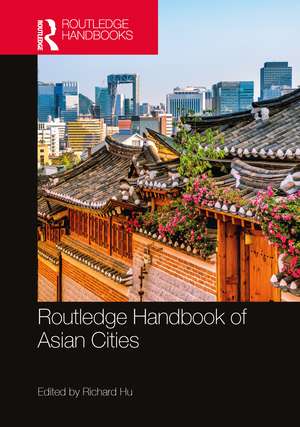Routledge Handbook of Asian Cities
Editat de Richard Huen Limba Engleză Hardback – 31 mai 2023
Investigating the urban challenges and opportunities of cities from every nation in Asia, the handbook engages not only the global cities like Shanghai, Tokyo, Singapore, Seoul, and Mumbai but also less studied cities like Dili, Malé, Bandar Seri Begawan, Kabul, and Pyongyang. The handbook discusses Asian cities in alignment to the United Nations’ New Urban Agenda and Sustainable Development Goals in order to contribute to global policy debates. In doing so, it critically reflects on the development trajectories of Asian cities and imagines an urban future, in Asia and the world, in the post-sustainable, post-global, and post-pandemic era.
Presenting 43 chapters of original, insightful research, this book will be of interest to scholars, practitioners, students, and general readers in the fields of urban development, urban policy and planning, urban studies, and Asian studies.
Toate formatele și edițiile
| Toate formatele și edițiile | Preț | Express |
|---|---|---|
| Paperback (1) | 354.97 lei 3-5 săpt. | +44.07 lei 7-13 zile |
| Taylor & Francis – 29 noi 2024 | 354.97 lei 3-5 săpt. | +44.07 lei 7-13 zile |
| Hardback (1) | 1381.61 lei 6-8 săpt. | |
| Taylor & Francis – 31 mai 2023 | 1381.61 lei 6-8 săpt. |
Preț: 1381.61 lei
Preț vechi: 1684.89 lei
-18% Nou
Puncte Express: 2072
Preț estimativ în valută:
264.55€ • 272.90$ • 219.26£
264.55€ • 272.90$ • 219.26£
Carte tipărită la comandă
Livrare economică 20 februarie-06 martie
Preluare comenzi: 021 569.72.76
Specificații
ISBN-13: 9781032188409
ISBN-10: 1032188405
Pagini: 546
Ilustrații: 22 Tables, black and white; 3 Line drawings, black and white; 57 Halftones, black and white; 60 Illustrations, black and white
Dimensiuni: 174 x 246 x 35 mm
Greutate: 1.14 kg
Ediția:1
Editura: Taylor & Francis
Colecția Routledge
Locul publicării:Oxford, United Kingdom
ISBN-10: 1032188405
Pagini: 546
Ilustrații: 22 Tables, black and white; 3 Line drawings, black and white; 57 Halftones, black and white; 60 Illustrations, black and white
Dimensiuni: 174 x 246 x 35 mm
Greutate: 1.14 kg
Ediția:1
Editura: Taylor & Francis
Colecția Routledge
Locul publicării:Oxford, United Kingdom
Public țintă
Academic, Postgraduate, and Undergraduate AdvancedCuprins
Part I: Introduction 1. Urban Asia in perspective 2. Smart cities in Asia: Ambiguity, innovation, and evolution 3. Asian cities in and beyond COVID-19 4. Vulnerable resilience in COVID-19: Invisibility and adaptability of the ‘informal’ cities of Southeast Asia 5. Making liveable cities: Experiences from Asia and the Pacific Part II: East Asian cities 6. East Asian cities: Deindustrialisation, greening, and the new geography of urbanisation 7. Hong Kong: One city, three spatial forms, and two possible fates? 8. Pyongyang: An urban metamorphosis under the power of marketisation 9. Seoul: Pursuing and sharing a global city 10. Shanghai: New directions in Chinese metropolitan planning 11. Taipei: Towards a liveable and sustainable city 12. Tokyo: Reinventing the modern Asian metropolis through adaptive strategies 13. Ulaanbaatar: When international plans and local preferences over urban densification collide 14. Xi’an: From an ancient world city to a 21st-century global logistics centre Part III: South Asian cities 15. South Asian cities: Informalisation of ecological and social change 16. Colombo: From colonial outpost to indigenous kleptocratic city 17. Delhi: Rethinking Indian urbanism through the capital’s multi-nuclei development 18. Dhaka: Growth management challenges for a rapidly urbanising megacity 19. Kabul: The 21st century urbanism we did not expect 20. Karachi: Changing institutional landscapes, challenges, and reforms 21. Kathmandu Valley: Unrealised proposals, decades of urban chaos and planning for a better future 22. Malé: Decentralising the world’s densest island capital—plans, determination, and challenges 23. Mumbai: ‘Mess is more’—value and shortcomings of the city’s ad hoc development process 24. Thimphu: Tranquil, peace, and happy city of the Himalayas Part IV: Southeast Asian cities 25. Southeast Asian cities: The imbalances of urban development 26. Bandar Seri Begawan: Why is Brunei’s capital chasing foreign dollars? 27. Bangkok: Creative disorder and the military imagination 28. Dili: Hurdles in constructing the urban from the ground 29. Ho Chi Minh City: Can it avoid the path dependence with Thu Duc City? 30. Jakarta: Seeking the sustainable megacity region 31. Kuala Lumpur: Post-Vision 2020 and post-pandemic futures 32. Manila: Aspiring to be an inclusive, resilient, and sustainable city amidst climate and disaster risks 33. Phnom Penh: Towards a post-dependency metropolisation? 34. Singapore: Planning for healthy ageing 35. Vientiane: Challenges in the policies and practices for sustainable urban development in a ‘least developed’ city 36. Yangon: Displacement urbanism, housing provisionality, and feminist spatial practices—an infrastructure of care at the urban margin Part V: Central Asian cities 37. Central Asian cities: Challenges in balancing global, national, and local development needs 38. Almaty: Modernisation through spatial reordering—urban networks, transport sector reforms, and Eurasianism 39. Ashgabat: The architecture as a showcase of a personal regime 40. Bishkek: Searching for Asianness in a post-Soviet city 41. Dushanbe: Urban transformation, changing spaces, and identities in Tajikistan 42. Tashkent: Aspiring for entrepreneurship and innovation hub Part VI: Conclusion 43. The Asian city in a new urban age
Notă biografică
Richard Hu is an urban planner, designer, and critic. His work and interests—both intellectual and professional—integrate built environment, economy, and technology to tackle contemporary urban transformations and challenges, with a focus on the Asia-Pacific region. He is the author of Smart Design: Disruption, Crisis, and the Reshaping of Urban Spaces (2021).
Descriere
This handbook provides the most comprehensive examination of Asian cities - developed and developing, large and small - and their urban development.
